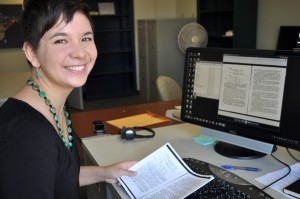
At first it seemed impossible, too amazing to be true, and she assumed she’d misunderstood. With the help of a translator, she was teaching a field course for students in a country whose native language she could not speak. Surely either she or the translator had heard incorrectly. But when two years later, while teaching the same course, she heard mention of the same dataset – a set of measurements taken in a remote and pristine lake over a 60-year time span, she knew she had to learn more. She was a freshwater ecologist studying lake ecosystems, and recognized immediately the rarity and potential value of a data set spanning such a long time span. She contemplated the possibilities and decided to get in touch with another researcher she knew had done an innovative time-series analysis with data from another lake. Together, they came up with the idea to initiate a collaborative project involving researchers from both countries to examine how the lake had changed over the 60-year time span.
Things went very well for the collaborative research team. A member of the core data collection team (and the granddaughter of the scientist who first began collecting the data 60 years earlier!) joined the research effort and was happy to share the data she and her family had been collecting for so long. She showed up for the first face-to-face research meeting with a shiny, new CD containing – THE DATA! The team eagerly set to work, and their enthusiasm and diligence paid off. Over the next couple of years, they published several high-profile research papers reporting their analyses of how things had changed over time in the lake ecosystem. A small clue about the existence of an amazing data set, together with the instinct to collaborate, the ingenuity required to pull a collaborative team together, and the willingness to share a valuable data set made some amazing discoveries possible!
Other researchers were paying attention to the research being done by the group. One ecologist who was eager to get involved contacted the team about possible future collaboration. It was at this point that the idea for a larger project began to take shape. After some initial disappointment with grant proposals, the NSF finally got excited about their research ideas, too, and the project was launched! With this new source of funds, they were able to hire some junior researchers to work on the project and to plan a field season trip to the lake itself.
The field season was WONDERFUL – a chance for the collaborators to experience the natural beauty of the lake, to meet the team that continues to collect the data, and to collect some additional data that they could use to complement the data already being collected by the on-site research group. The team returned home at the end of the season reinvigorated and with fresh enthusiasm to start the analyses they had planned.
It was at this point that one of the junior researchers noticed that there was something missing. As he started working with the data, he realized that he didn’t know how to interpret some of the data values. He was interested in how species diversity in the lake had changed over time, and he needed to know the total number of individuals that had been counted for each sample so that he could control for the fact that when more individuals are counted, more species are likely to be identified. He came to the realization that he would be unable to do the analyses he had planned without having more detailed information about exactly how the measurements were taken and recorded. Fortunately, the collaboration team had a working meeting scheduled, so he prepared a set of questions to ask of the collaborator whose family had been collecting the data for so many years. Satisfied that his questions would soon be answered and that he would be able to get started on the analyses he had planned, he turned his mind to other projects until the week of the meeting.
When the meeting began, he was prepared to get the information that would allow him to proceed with his analysis. He scheduled some time to meet with the collaborator, and he began to ask his questions. When the collaborator began to understand more about the kind of information he was looking for, she happily informed him that the data collection team had a research protocol that contained the information he would need for his analysis. She promised to send him a copy when she returned home from the meeting. This was great news – he would soon have the formal documentation of the research protocol!
Two months after the collaboration team meeting (and after dealing with some problems with internet connectivity and missed connections while researchers were on vacation), the researchers received a copy of the protocol that had been scanned from hardcopy. After so much anticipation, the protocol had arrived! Only one little problem – it was a 50-page document, and it was not written in English.

Translating the document took some time – two more months, in fact. Because the document had been scanned from hard copy, it wasn’t perfectly legible. The language was technical and sometimes difficult to translate. But the team member doing the translation (the data manager for the project) was excited to help uncover the missing information and willing to put up with the hard work required to find it. This blend of curiosity and determination (and, of course, a good command of the foreign language), helped the research team sort out the information needed to get the project back on track.
After dedicating considerable time and effort to retrieve and translate the data collection protocol, the team produced two electronic copies – one foreign-language version, the other English – so that all the researchers working with the data now and in the future would have access to using and sharing this important metadata. Now in digital format, the data collection protocol was linked to the 60-year dataset – never to be parted again.
When a project fails to go exactly as planned, it’s tempting to look at those pitfalls along the way and imagine how they could have been avoided. Here, the team might have dodged some of the confusion if they had known about the protocol’s existence from the beginning. But in a collaborative project of this size, stretched across two continents and with an added language barrier, unexpected challenges can float to the surface without warning and put all research plans on hold. In these instances, a little patience, determination, and creative problem solving can be all it takes to find a solution. In the case of the missing research protocol, a healthy helping of each shaped a 60-year legacy of data collection into an accessible dataset of ecological significance.
